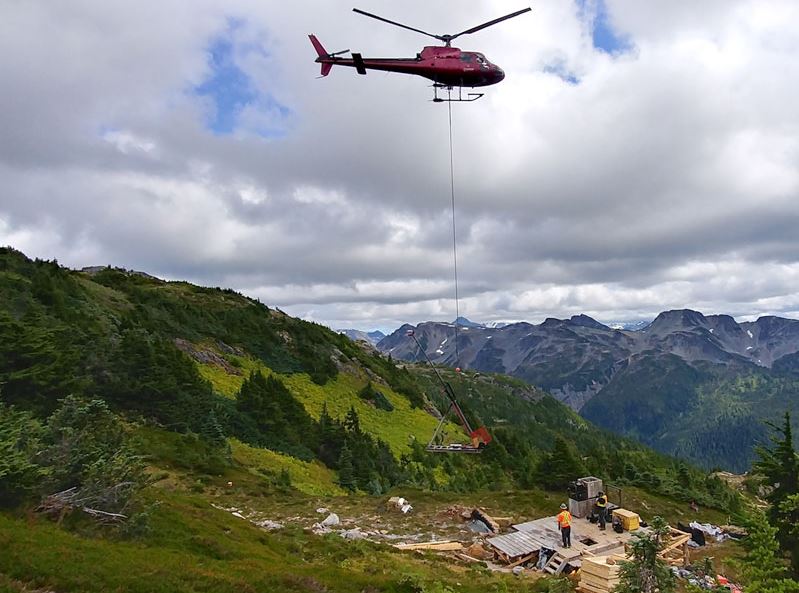Juggernaut shares fall on B.C. drilling update

Juggernaut Exploration Ltd. [JUGR-TSXV] shares fell 62.5% in active trading Monday September 30 after the company released results from 2019 drilling on its Midas and Empire properties in central British Columbia.
Juggernaut is focused on two project areas – Empire and Midas – which are located south of B.C.’s Golden Triangle. Both projects were identified within the last two years by prospecting in areas of receding snow and ice covering. Prior to Juggernaut’s recent drilling activity, little work has been completed on either project apart from first-pass rock-chip sampling, preliminary mapping and drone imagery.
Empire and Midas are held under option agreements with DSM Syndicate, a private prospecting firm, which is 20%-owned by Juggernaut. The option agreements required Juggernaut to pay $4.1 million in cash over five years and issue 20.5 million Juggernaut shares and 8.2 million warrants at 8 cents a share. That adds up to a spending commitment of $13.35 million per project.
The Midas property covers 16,653 hectares. Like Empire, it is accessible by logging tracks and is located 10 km from Terrace, or 14 km from power, rail and road infrastructure.
Midas features an 18 to10-km alteration zone of oxidation and quartz-sericite-pyrite alteration. The King Solomon Zone is of particular interest, as it hosts a 2.1 by 1.6-km area of polymetallic and gold mineralization that is interpreted to be VMS (Eskay Creek) style and has been defined by both the British Columbia Geological Survey and Juggernaut.
Rock-chip and channel sampling previously revealed a number of visible gold showings and high-grade gold mineralization, including 4.34 metres grading 10.28 g/t gold and 3.11 metres grading 5.43 g/t gold (including 0.55 metres, grading 14.55 g/t gold).
On Monday, Juggernaut said the 2019 drill program, consisting of 2,548 metres in nine drill holes revealed several zones, confirming the presence of gold and base metals in a potential VHMS to orogenic gold system near surface and at depth. “These mineralized zones are typically associated with strongly silica-sericite altered volcanics and can be associated with polymetallic quartz veining throughout the King Solomon trend,” the company said.
Drilling highlights include hole MD-19-18, which intersected several mineralized gold to copper bearing zones hosted within strongly silica-sericite altered volcanics, including 6.22 metres of 0.313 g/t gold from 8.53 to 14.75 metres, 0.95 metres of 1.495 g/t gold with 1.940% copper from 35.8 to 36.75 metres and 3.22 metres of 0.362 g/t gold from 93.83 to 97.05 metres
Hole MD 19-19 intersected 1.8 metres of 1.87 g/t gold from 187.7 to 189.5 metres, indicating the presence of quartz-pyrite gold bearing veins at depth.
The Empire property covers 16,000 hectares. It consists of several targets revealed by the retreat of glaciers and snow packs, with extensive porphyry dikes and potassic and propylitic alteration believed to be associated with a porphyry-style deposit along an area known as the Inca Trend.
Juggernaut said the 2019 drilling program at Empire focused on testing two targets within the upper Rockstar Zone generated from the 2018 surficial grab samples and IP survey. Hole EM-19-19 tested a near surface IP anomaly and did not intersect any significant mineralization or lithology. Therefore the anomaly remains unexplained. The final hole (EM-19-20) intersected 4.7 metres of 1.173% copper with 0.114 g/t gold from the top of the hole.
“The results of this program indicate there remains good potential for structurally controlled and VHMS mineralization to be discovered within the underexplored King Solomon trend on the Midas property,” said Dan Stuart, President and CEO of Juggernaut.
“The 2019 data will aid in planning for future drilling as we continue to gain a better understanding of the property,” he said.
Meanwhile, the share price fell 62.50% or $0.025 to $0.015 on volume of 3.3 million, making Juggernaut one of the most active stocks on the TSX Venture Exchange on Monday. The shares were previously trading in a 52-week range of $0.035 and 33 cents.
